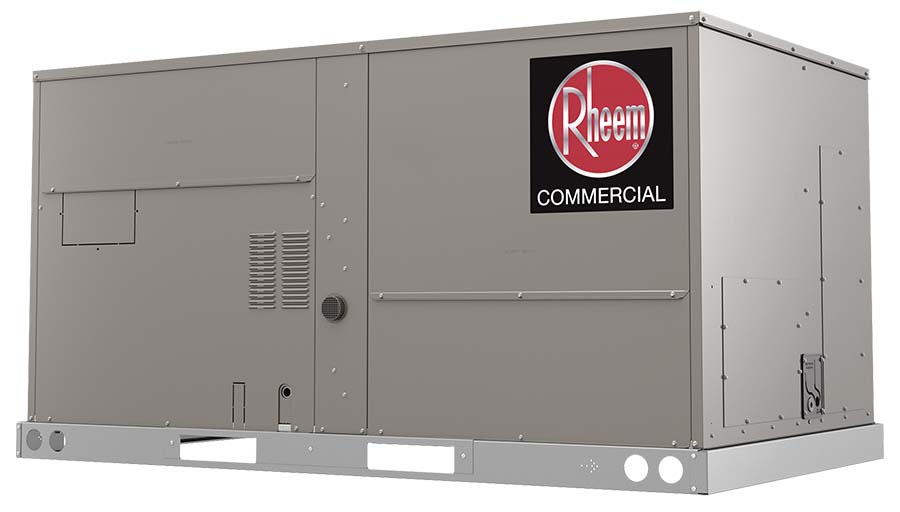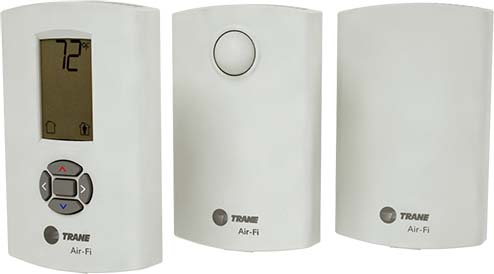With each passing year, rooftop system developers find new ways to improve this staple piece of HVAC commercial equipment. The focus of these trends is moving past the four steel walls of the unit and providing new options that further address efficiency, IAQ, building controls, and sustainable solutions. With the evolution of these mechanisms and the environment in which they are developed, manufacturers take time to create systems that will not only meet the current needs of customers, but also surpass the expectations of current functionality.
Product Trends in Rooftop Technology
Daikin Applied is one manufacturer that is setting new trends in rooftop equipment. With a strong focus on adaptability and increased use of direct drive ECM fans, the company’s rooftop line is expanding. Daikin Applied recently released the Rebel Applied® rooftop unit that features a high-efficiency motor and compressor and meets ASHRAE Standard 111 Class 6 air-leakage rating at +/-6 inches or 0.5 percent at design airflow. There is no need for transition curbs, and the product can be used in new construction or retrofit applications.
“Adaptability not only pertains to technical complexity, but size as well,” said Matt Dodds, product manager, Daikin Applied. “For example, the new Rebel Applied rooftop system is up to 37 percent shorter in length and 30 percent lighter than legacy RTUs [rooftop units]. It also has a base channel that adapts to different types of curbs, often eliminating the need for a transition curb, which saves installation time and costs.”
At Rheem, motor technology is changing rapidly, which is cause the company to make its designs more efficient and capable, according to Rosa Leal, senior product manager, Rheem.

MULTIPLE OFFERINGS: Rheem’s 3- to 5-ton Commercial Renaissance™ HVAC line is offered in a single-phase and three-phase reheat design. It is available in gas electric and electric cooling models.
“The motor technology also allows for more options for direct-drive blowers and multi-speed blowers capabilities including VAV,” she said. “This technology is used to increase IEER, meet minimum DOE efficiency, and meet Title 24 and IECC regulations and building codes.”
The company’s 3- to 5-ton Commercial Renaissance™ HVAC line is offered in a single-phase and three-phase reheat design. It is available in gas electric and electric cooling models. Equipped with Rheem’s PlusOne® Humididry™, the equipment is a single phase-reheat solution. PlusOne Humididry is an all-microchannel heat exchanger design for commercial and residential application. This system is ideal for schools and any spaces with high humidity to maximize comfort and to provide IAQ. It utilizes a dual phase system, which allows it to achieve higher latent capacity and neutral air for more humidity removal.
“Microchannel heat exchangers are quickly evolving, allowing more options for evaporators, heat pumps, multi-circuit, larger capacities, and sustainability goals,” said Leal. “We are seeing more dehumidification rooftops being utilized as buildings continue to adapt to meet demands for ventilation and resolve IAQ concerns.”

COMFORT CONROLS: The Trane® Zoned Rooftop System is available in single- or multiple-zone configurations. Some models feature Air-Fi™ wireless controls that enable flexibility in sensor location, have a self-healing mesh networking, and can be easily relocated to accommodate future space use changes.
According to Trane Commercial HVAC America portfolio marketing, the rooftop market has progressively strengthened over the last several years, and the company continues to see trends in building controls, connectivity, and sustainable solutions. It is addressing these trends with the Trane® zoned rooftop systems. Tracer® Concierge™ goes beyond managing individual rooms by operating the entire HVAC system. Available in single- or multiple-zone configurations to provide comfort control for different areas of the building with varying comfort needs, the packaged rooftop equipment provides cooling, heating, and ventilation on a single piece of equipment. Air-Fi™ wireless controls enable flexibility in sensor location, have a self-healing mesh networking, and can be easily relocated to accommodate future space use changes.
“Improved efficiency is a trend we consistently see across the board, even outside of our rooftop products, as customers seek out better energy use and sustainability practices,” the company said in a statement. “At Trane, our mission is to reduce the energy intensity of the world, which we do by maximizing a building’s potential for the highest levels of operation and energy efficiency at every life cycle stage. We take advantage of the newest technologies available to improve comfort and increase efficiency for our customers.”
The Future of Rooftop Technology
Looking ahead to what comes next for rooftop systems can be challenging. One topic that is likely to be on top of the list, however, is refrigerants — especially A2L refrigerants.
“The next big improvement you will see on rooftop systems will be the transition to A2L refrigerants,” said Leal. “This will come for the current pressing designs, including emerging technology such as multi-capacity compressors.”
Daikin Applied said it understands the importance for manufacturers to optimize their designs around new refrigerants.
“They have to address energy efficiency, along with charge levels,” said Dodds. “Technologies that are ultra-efficient and operate with a low refrigerant charge can reduce the carbon footprint of equipment far beyond the GWP reduction of the refrigerant fluid itself.”
Adapting and designing for new refrigerants isn’t the only new challenge on manufacturers’ lists of things to do. There is also a trend emerging of rooftop manufacturers moving away from the one-size-fits-all unit as they begin to integrate with other HVAC technologies.
“With today’s manufacturing technologies, rooftop solutions are now flexible and scalable,” said Dodds. “They can include many features that have been historically reserved for more expensive custom equipment, such as extra filtration, UV lights, energy recovery systems, and more.”
Rooftop Technology and the Occupants
In order to help the HVAC contractor with equipment decisions, Trane explained that good rooftop installations begin with cost-effective options to increase comfort and energy efficiency while simplifying operation and maintenance. The company advised that those who install rooftop units should have access to local equipment and accessories, the ability to offer immediate like-for-like equipment needs, and quick delivery.
“Good rooftop installation centers around end user needs for temperature and humidity control, maintainability, and indoor air quality,” said Dodds. “Features such as inverter compressors improve energy efficiency and thermal comfort. Additionally, beltless direct drive fans reduce annual maintenance costs, and high-efficiency, high-capacity filters improve indoor air quality for building occupants.”
He explained that Daikin Applied will continue to add new features to its Rebel Applied, such as additional energy efficiency technologies, refrigerants, and IAQ-enhancing solutions.
“We’re also reinventing technician training for Rebel Applied to ensure we bring the training to them for a more convenient, accessible, and always-on experience,” he said.



Report Abusive Comment